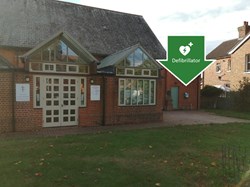Defibrillator
Locations
Rusthall currently has 2 defibrillators:
1. On the outside wall at the United Reformed Church, Manor Road
2. On the outside wall at the Toad Rock Retreat, Upper Street
- Toad Rock Retreat, Upper Street
- United Reformed Church, Manor Road
How to use a defibrillator
(Advice from St John Ambulance)
1. After performing a primary survey, and you find someone is unresponsive and not breathing normally, ask a helper to call 999 or 112 for emergency help while you start CPR. Ask a helper to find and bring a defibrillator, if available.
- If you're on your own use the hands-free speaker on a phone so you can start CPR while speaking to ambulance control.
- Do not leave a casualty to look for a defibrillator yourself, the ambulance will bring one.
2. When the helper returns with a defibrillator, ask for it to be switched on and to take the pads out, while you continue CPR. They should remove or cut through clothing to get to the casualty's bare chest. They also need to wipe away any sweat. The defibrillator will give you voice prompts on what to do.
3. They should attach the pads to the casualty’s chest, by removing the backing paper. Apply the pads in the positions shown.
- The first pad should be on the upper right side below the collar bone.
- The second pad should be on the casualty’s left side below the arm pit.
4. The defibrillator will analyse the heart’s rhythm. Stop CPR and make sure no one is touching the casualty. It will then give a series of visual and verbal prompts that should be followed.
- If the defibrillator tells you that a shock is needed, tell people to stand back. The defibrillator will tell you when to press the shock button. After the shock has been given the defibrillator will tell you to continue CPR for two minutes before it re-analyses.
- If the defibrillator tells you that no shock is needed continue CPR for two minutes before the defibrillator re-analyses.
5. If the casualty shows signs of becoming responsive, such as coughing, opening eyes or speaking, and starts to breathe normally, put them in the recovery position. Leave the defibrillator attached. Monitor their level of response and prepare to give CPR again if necessary.
More life saving techniques and videos can be found on the St John Ambulance website sja.org.uk

